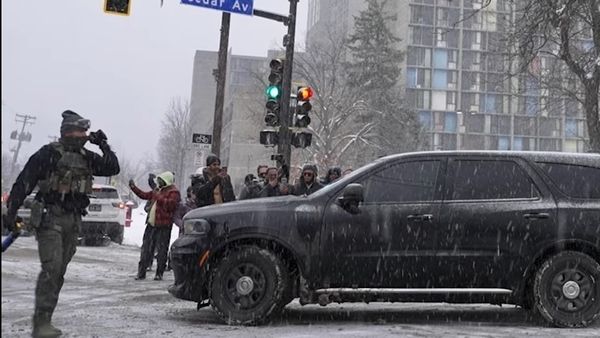
ROME — The retired women wheeled their canvas shopping carts to the fresh pasta counter of an outdoor market in Rome this week and commiserated about how the price of tagliatelle, oranges, napkins, utility bills — you name it — had gone through the roof.
“Prices have gone up on everything,” said Simonetta Belardi, 69, a self-described leftist who argued that while inflation whittled away her savings, it also wore down her support for Ukraine in the war that many across Europe blame for the astronomical costs. She was no fan of Russia, she said, but the time had long passed for an end to military support for Ukraine and a shift to diplomatic negotiations for peace. She said more and more people she knew, in need of economic relief, were losing their patience, too.
“All they want is arms, arms, arms,” she said of Ukraine. “I’m sick and tired of them.”
It is a sentiment — impatience, even inchoate anger, at the inflation fueled by the war — that transcends the shoppers in Rome’s piazzas and can be found among the weekly protests in Germany or in the swelling ranks of French strikers. And it has leaders nervous.
While Britain’s economic tailspin was largely self-inflicted by unfunded tax proposals, the resignation on Thursday of Prime Minister Liz Truss sent perhaps the clearest signal yet that political peril awaits those who fail to address inflation and the erosion of living standards, no matter the cause.
The situation is arguably even more dire on continental Europe. The annual inflation rate in the European Union is at its highest in decades — 10.9% in September, up from 3.6% a year earlier.
That is worse even than in the United States or Britain, and it is being driven largely by the bloc’s unique and anguishing withdrawal pains as it tries to punish Russian President Vladimir Putin for his invasion of Ukraine by quitting its long dependence on cheap Russian gas.
As winter approaches, Europe’s united turn away from Russian energy is beginning to bite in households everywhere, eroding living standards and in some countries threatening to chip away at the united front for sanctions against Russia.
Mario Draghi, the departing prime minister of Italy and an architect of the continent’s united line against Russia, warned as much would happen if Europe failed to reach a deal to cap prices on the alternative gas imports.
Spiraling energy costs, he said in a speech at the United Nations in September, would be something that “puts at risk the economic recovery, limits the buying power of families and damages the production capabilities of businesses.”
It “can wear down the commitment of our countries toward Ukraine,” he added.
That moment, it seems, is arriving as strikes and protests over the rising cost of living proliferate, ushering in a period of social and labor unrest not seen since at least the 1970s.
“We have seen this after the First World War, Second World War and also in the ’70s,” said Kurt Vandaele, a senior researcher at the European Trade Union Institute. “There were strike waves associated with a real spike in inflation.”

In Italy, the pressure is everywhere. Trade unions want the government to spend more on energy subsidies to help companies like pottery makers, who need to power their furnaces, but also farmers, who are getting slammed on the cost of fertilizers, which are produced with gas or potassium from Russia.
This week, former Prime Minister Giuseppe Conte, who has recast himself as a populist hero of the poor in Italy’s south, announced he would join a large demonstration on Nov. 5 demanding peace for Ukraine and an end to arms shipments. Critics say he is advocating Ukraine’s surrender.
As elsewhere, the incoming right-wing government of Giorgia Meloni will have to struggle with how to cushion inflation’s blow without inflating already bloated deficits. Draghi, a former president of the European Central Bank, has argued that running a higher deficit would spook international markets, raise interest rates and hurt Italians.
Whether that can be avoided while resisting Putin and the temptation of Russian energy is the question.
But the Baltic countries, which are taking the hardest economic hit, have shown that opposition to Putin remains the priority.
Estonia, which last month registered an inflation rate of 24%, the highest in Europe, has not wavered on the war. Nor has Lithuania or Latvia, where inflation is running about 22%. But the loss of purchasing power is not without political consequence.
Support for Estonia’s far-right nationalist party just six months before a parliamentary election has grown, although it has shown no sympathy for Putin, and it supports sending arms to Ukraine.
And while fringe groups have turned out for protests in the Czech Republic, where inflation last month rose to 17.8%, the pro-EU government seems strong.
But in Hungary, also hammered by more than 20% inflation because of a surge in household energy prices, the Euroskeptic prime minister, Viktor Orban, has doubled down on his policy of denouncing sanctions against Russia in pursuit of deals with Russia’s state-owned Gazprom for supplies of natural gas.
For its part, Britain has strongly supported Ukraine, but as Truss’ government imploded under the weight of its own reckless economic policies, a debate emerged about whether to cut back on military spending even as Ukraine seeks more arms.
In Germany, Europe’s biggest economy, the leadership is trying to spend its way out of the crisis as only it can. But even there it’s not clear the relief will be felt in time, and whether it will exacerbate the country’s already deeply divided stance on how to help Ukraine and whether to work with Russia or isolate it.
Today, 67% of Germans worry about rising costs of living — 16% higher than last year. It’s the country’s top concern, despite government aid packages.
In the eastern states that are among the country’s poorest, and most conservative, tens of thousands of protesters take to the streets weekly, combining their critique of high prices with support for Ukraine in the war. The left has started organizing protests that mirror the complaints of the right. In Leipzig, Germany, where some 1,300 demonstrators gathered downtown, signs read, “Our country first.”

“The economic stress is palpable everywhere,” said Daniel Schmal, a 23-year-old who recently closed his import-export business in the city and started driving for a ride-sharing app. “You’re going to see a lot more businesses or factories closing.”
German authorities said that an aid package of 200 billion euros that was proposed by the government earlier this month appeared to have eased some popular anxiety, with promises of gas and electricity price caps, as well as direct aid to struggling families and businesses.
But in France, the strikes and demonstrations are gaining in intensity as a fear of eroding living standards dominates concerns, polls indicate.
Inflation, pushed by soaring energy prices, will shave $73 billion from the gross domestic product and shrink France’s purchasing power by 1.4% next year, with the effect felt largely in poorer households, a recent study predicted.
“The energy crisis is very unequal,” said one of the study’s authors, Éric Heyer, an economist at the Paris-based French Economic Observatory.
On Tuesday, France’s main unions led large demonstrations in Paris, with tens of thousands marching for wage increases, and a survey last week by the polling firm IFOP found that support for Ukraine was down about 5 percentage points since May.
In August, President Emmanuel Macron of France called on people to endure the economic hardship as a show of solidarity with Ukraine, and conservation efforts have reduced French energy consumption by 14%. It was France’s duty to “accept the price of our freedom and values,” Macron said.
While there is still general opposition to Russia, on the question of sacrificing purchasing power to support Ukraine, “public opinion is much more divided,” said Adrien Broche, the co-author of a study showing that only one-third of the French now agree with bearing the economic consequences of the war.
In Italy, Meloni has had to assure skeptics that she would keep Draghi’s hard line against Russia despite having in her coalition Matteo Salvini, a populist leader who used to wear shirts with Putin’s face on them, and Silvio Berlusconi, who this week was caught on tape privately blaming Ukraine’s president, Volodymyr Zelenskyy, for forcing Russia to invade.
Lorenzo Codogno, a former director-general of the Italian treasury who runs a consulting firm that closely follows Italian politics, said he thought Meloni would maintain her strong support of Ukraine but would probably appeal to Europe to help lower taxes on core food items to help low-income Italians.
“You need to find some kind of agreement,” he said, “at the European level.”
At the Roman market, not all were ready to abandon their commitment to Ukraine despite the costs.
Anna Andolfi, 77, who loaded some bread and pastries into her canvas cart, said that she had noticed that many of her friends, even those more well off than she, had increasingly voiced their impatience with Italy’s support for Ukraine, given the high prices for food and heat and Ukraine’s seeming “a world away.” But she said that a young Ukrainian woman helped her out at home and that the girl fretted constantly for her mother in Lviv.
“I don’t care how much the prices go up,” she said. “I’ll turn the heat off and wear two ski suits if I have to so that we can keep supporting Ukraine.”
View original article on nytimes.com
© 2022 THE NEW YORK TIMES COMPANY







